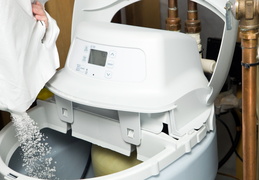Congratulations on your new water softener! Whether you choose it for better-tasting water, healthier skin and hair, or to protect your plumbing from hard water buildup, keeping it running smoothly is key. If you recently scheduled a water softener installation in St. Albert, AB, you’re probably wondering what comes next. Don’t worry—WeatherMakers Heating, Cooling & Plumbing is here to guide you through the essentials of post-installation maintenance.
Why Maintenance Matters
Water softeners are designed to work quietly in the background, but like any hardworking appliance, they need a little attention now and then. Regular maintenance ensures your system continues to remove hardness minerals efficiently, protects your home’s plumbing, and extends the lifespan of the softener.
Neglecting maintenance can lead to reduced performance, costly repairs, or even premature replacement. A little maintenance now can prevent major headaches and expensive fixes down the road. Think of your water softener as an investment. With a few simple maintenance steps, you’ll get the best return on it for years to come.
Key Water Softener Maintenance Tips
1. Check Salt Levels Regularly
Salt is the fuel your softener needs to regenerate and flush out hard minerals. We recommend checking the salt level in the brine tank at least once a month. Keep the salt level at least half full, and always top it off with high-quality salt pellets—not rock salt, which contains impurities.
2. Clean the Brine Tank Annually
Over time, sludge or salt bridges can form in the brine tank, reducing efficiency. A yearly cleaning helps prevent this. Simply empty the tank, rinse out any residue, and refill with fresh salt. If you’re unsure how to do this, give us a call—we’re happy to help.
3. Inspect for Salt Bridges and Mush
Salt bridges are hard crusts that form in the brine tank, while salt mush is a sludgy mess that blocks water flow. Both can stop your softener from regenerating properly. Gently poke the salt with a broom handle to ensure it’s loose and not clumped.
4. Keep an Eye on Water Softener Settings
Make sure the system is regenerating as needed based on your household’s water usage and hardness levels. Many modern softeners adjust automatically, but it’s good practice to double-check your settings periodically.
5. Schedule Professional Servicing
While DIY maintenance covers the basics, a professional inspection once a year can catch issues you might miss. Our technicians can test water hardness, inspect internal components, and perform a full system check to keep your softener in peak condition.
Enjoy the Benefits of Soft Water Without the Hassle
At WeatherMakers Heating, Cooling & Plumbing, we don’t just install equipment—we make sure you know how to keep it working for the long haul. A well-maintained water softener saves you money, protects your appliances, and ensures every drop of water in your home is as clean and soft as it should be.
If you have questions about your water softener, need professional maintenance, or are noticing signs it’s not working as it should, don’t wait.
Contact WeatherMakers Heating, Cooling & Plumbing. Ensuring Your Comfort… For Life!

